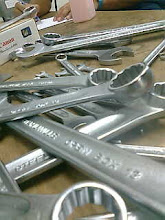| Hack | 1920-23. Scooter. |
| Haden | 1920-24 |
| Hamilton | 1901-07 |
| Hampton | 1912-14 |
| Hansa | 1920-22 |
| Hansan | 1920-22 |
| Harper | 1954-55. Scooter. |
| Harewood | 1920 |
| Hawker | 1920-23. Designed by aircraft pioneer Harry Hawker. |
| Haxel-JAP | 1911-13 |
| Hazel | 1906-11 |
| Hazelwood | 1905-23. Many exported. |
| HB | 1919-24 |
| Healey | Built in Redditch in small numbers by the Healey brothers, 1968-74. |
| HEC | 1922-23. Another company of this name made autocycles 1939-55, merged with Levis during WW2. |
| Henley | 1920-29 |
| Hercules | 1955-61. Made mopeds. Another company in Derby made motorcycles in 1902 under this name. |
| Hesketh | 1980-82. Lord Hesketh planned to revive the failing British motorcycle industry. In 1981 he started with a new high-tech bike, the V-twin V1000, that offered all sorts of advances - the first British bike with four valves per cylinder and twin camshafts (although commonplace in Japanese machines). But lack of funding, technical problems and too much weight plagued the V1000. Despite some interest in putting Triumph badges on the bikes (Triumph was really in no position to fund it by now), after making 139 bikes, the company went bust in 1982. In 1983, Hesketh formed a new company (Hesleydon) to manufacture a revamped V1000 with a full fairing, called the Vampire, but it retained too many of the V1000's faults and only 40 were produced before the company closed again. Broom Development Engineering has continues to provide support for Hesketh motorcycles, even making around a dozen bikes a year. |
| HJ | 1920-21 |
| HJH | 1954-56. Welsh company. |
| Hobart | 1901-23 |
| Hockley | 1914-16 |
| Holden | ??? German company 1898-1903. May have had British subsidiary. |
| Hoskinson | 1919-22 |
| Howard | 1905-07 |
| H&R | Hailstone & Ravenhall. Also known as R&H. 1922-25. |
| HRD | Started by famed racer and WW1 pilot Howard Raymond Davies in 1925, after which he won the 1925 Senior TT on one of his own machines. HRD created three initial models using JAP engines, all designed for racing. Despite their quality, the bikes were expensive, so he tried to make lower-cost models, but he went bankrupt in 1928. OK Supreme acquired the name briefly only to sell it to Phil Vincent shortly after. The HRD name was dropped in 1950. See also Vincent. |
| Hulbert-Bramley | 1903-06 |
| Humber | Founded by Thomas Humber in 1868 (1870?) to make penny-farthings, then turned to bicycles. Made the first diamond-frame in 1884. Financial whiz-kid Terah Hooley took over the company in the 1880s, and Humber left in 1892. The company started experimenting with powered machines in 1896, working with entrepreneur Harry Lawson, who had the rights to build the De Dion engine, in Coventry. Lawson also had the rights to De Dion's tricycle, which Humber made for him in 1898. Started building P&M machines under licence in 1902 and exhibited their own Beeston-Humber machines in 1903. By 1908 they had their own lineup and soon had several race winners including the Junior TT in 1911. They announced a 750cc flat-three in 1913, but never produced it. In 1914, they made a water-cooled 500cc single and a water-cooled 750cc flat twin. During WW1 they made sidecar outfits for the war effort, returning to civilian production in 1919. Their 2 3/4 hp model had a great success in 1923 in the Scottish Six day Trials. In 1927 they announced a 350cc ohc machine, but it wasn't successful. Sales slumped and by 1931 the company had left motorcycling to concentrate on cars. Bicycle business was sold to Raleigh. |
Saturday, 13 August 2011
British motorcycle manufacturers - H
Subscribe to:
Post Comments (Atom)






0 comments:
Post a Comment